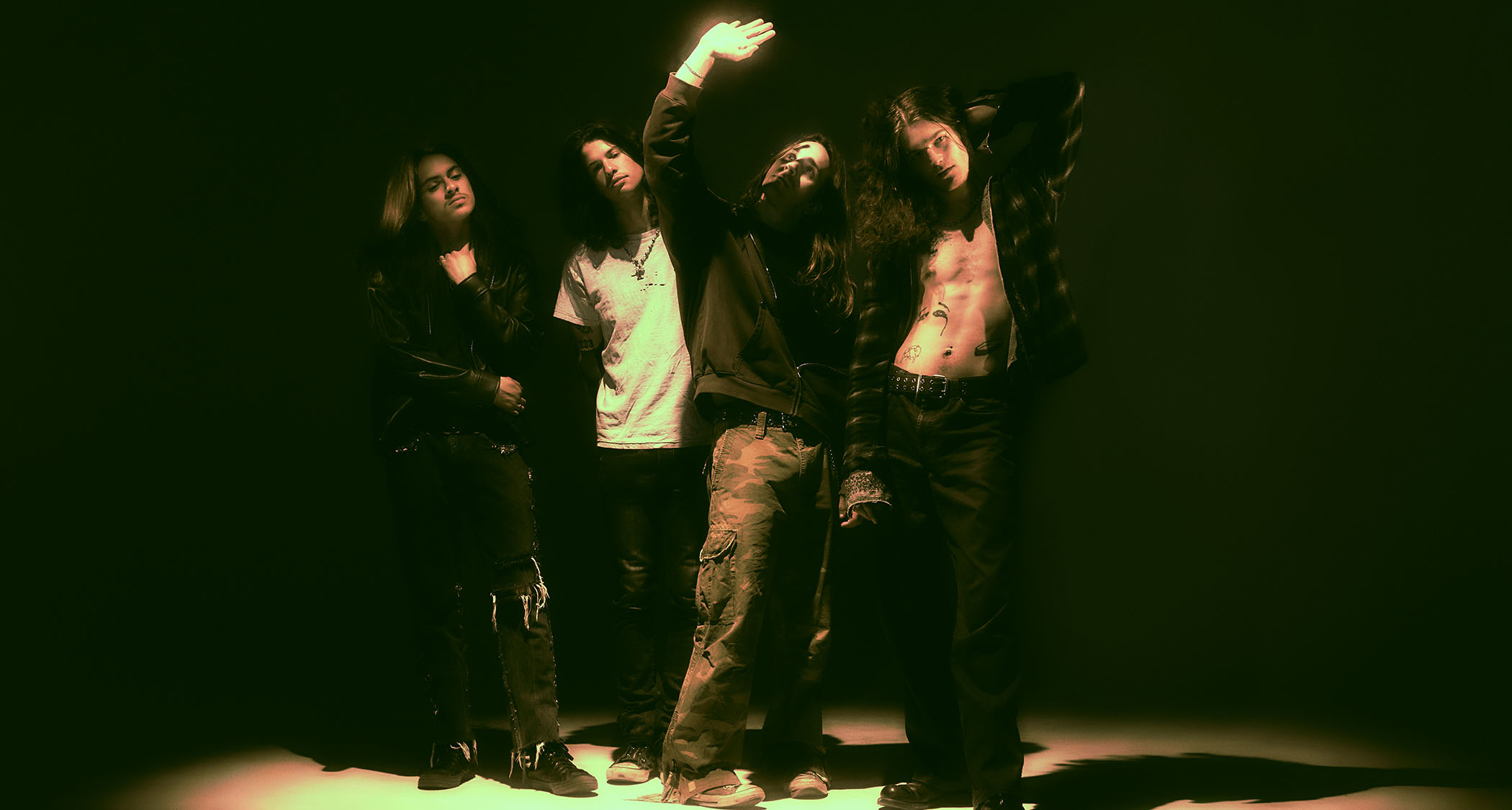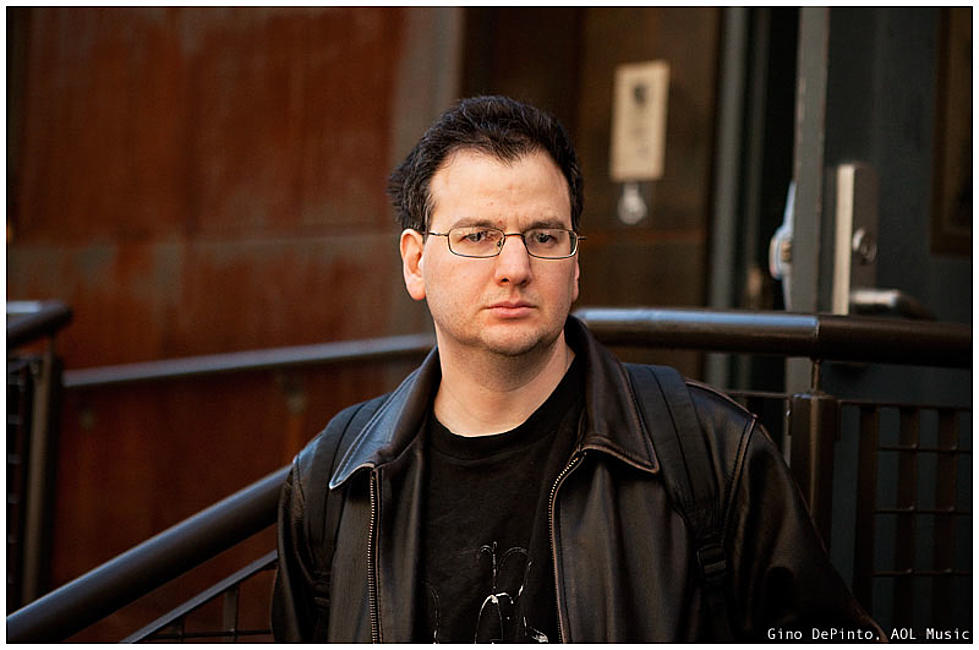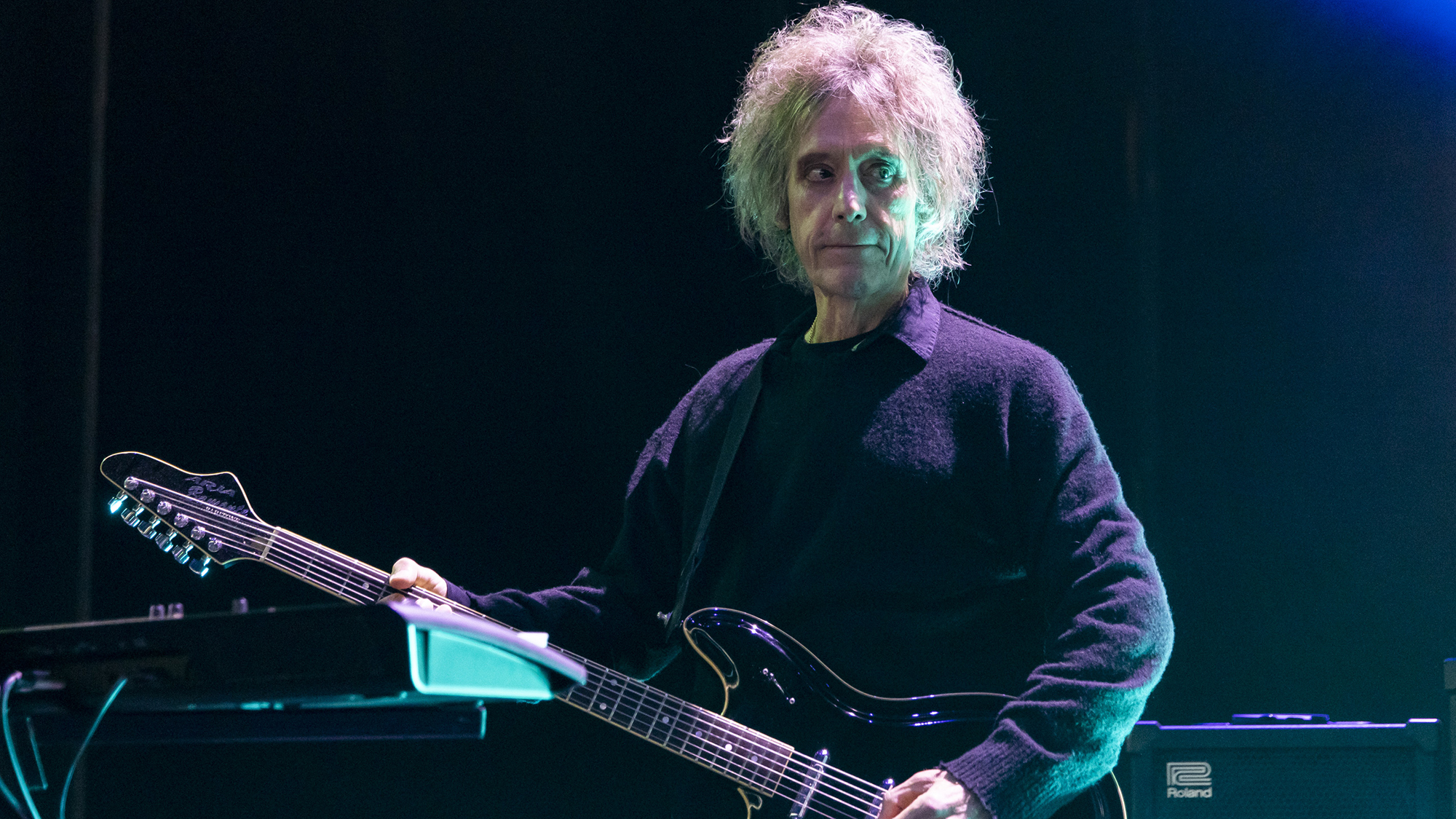“My mom got right in their faces and said, ‘This is my son. He plays guitar and he wants to join a band.’ I was totally embarrassed”: How Return to Dust found their teen guitar phenom and put a fresh face on ’90s grunge
Sebastian Gonzalez was too young to drive a car but not to blew Matty Bielawski away with his chops. He is the Cali band's secret weapon as they take drop D riffs in thrilling new directions
![Black-and-white action shots of Return to Dust guitarists Matty Bielawski [left, with a Gibson SG] and Sebastian Gonzalez [playing a PRS].](https://cdn.mos.cms.futurecdn.net/ou9XjWTCia4HnLufE34tHc.jpg)
A few years ago, a then 15-year-old Sebastian Gonzalez was taking a walk around his Inglewood, Los Angeles neighborhood one evening with his mom. Turning a corner, they heard the muffled sound of an alternative metal band practicing from behind a closed garage door.
Since Gonzalez was an accomplished guitar player, his mom told him to knock on the door and introduce himself, and that maybe he could join them.“No, way!” the teen blurted. “They’re busy practicing. I’m sure they’ve got a full band and don’t need some kid.”
Undeterred, Gonzalez’s mom walked over to the garage door and, to her son’s horror, repeatedly banged on it. The musicians inside stopped what they were doing to see what was going on. The door opened and two twenty-something musicians peered out to see if the police were about to give them a noise violation.
“My mom got right in their faces and said, ‘This is my son. He plays guitar and he wants to join a band,’ Gonzalez says. “I was totally embarrassed.”
The teenager sheepishly apologized and told the musicians, guitarist Matty Bielawski and bassist Graham Stanush, to please excuse his mom and that he didn’t mean to interrupt them.
“Do you play lead guitar?” Bielawski asked. “Are you good?”
Gonzalez, who had been playing guitar since he was 10, said he loved to shred, and his greatest influences were Kirk Hammett, Dimebag Darrell and Paul Gilbert. So Bielawski asked the kid to write down his number and told him to expect a call with an invitation to jam.
All the latest guitar news, interviews, lessons, reviews, deals and more, direct to your inbox!
As excited as he was, Gonzalez figured Bielawski, whose band sounded tight and professional, was just being polite. A week after his mom knocked on the door, Gonzalez had pretty much given up hope. Then, his phone rang. It was Bielawski asking him back to the garage to audition for the lead guitarist slot in his band, Return to Dust.
“I brought over my Flying V guitar and this really crappy pedalboard system that was super broken, and we jammed for two or three hours,” Gonzalez recalls, brushing long, wavy hair out from in front of the left side of his face. “I was afraid I’d be nervous and freeze up, but it was some of the most magical playing I’ve ever done. I started to feel a lump in my throat because it was an emotional moment. They really seemed to like what I was doing.”
Return to Dust asked him to learn some of their songs, and by the next jam session, Gonzalez was in the band. His slick, articulate runs were just what the group needed to complement Bielawski’s trudging drop-D riffs and minor-key harmonies.
When you watch Seb, it’s just obvious that all he did growing up was sit in his room playing Metallica
Matty Bielawski
Right away, they went from being an enticing Alice In Chains-inspired act to a band that pays homage to their heroes while incorporating their own artistic flair.
“When you watch Seb, it’s just obvious that all he did growing up was sit in his room playing Metallica,” says Bielawski, whose bushier locks are more cultivated than Gonzalez’s. “He just rips over everything. At first, we had to tell him to tone it down a bit because he was shredding all over us singing. But he was just excited to play with us.
“Once he calmed down a little, everything fit into place. He’s got a very musical brain and even though he’s young, he just gets it. It was like all the fates aligned for us that first day he came over.”
Now, following a self-released full-length and a deal with Lava Records, Return to Dust are getting ready to release Speak Like the Dead, an EP featuring six new songs, including the driving, anthemic single Shine and the more layered, intricate Bored.
I really don’t mind when people hear Alice in Chains in our band because it’s definitely there. But all the stuff on our old records was written three or four years ago
Matty Bielawski
The grunge flavor is still there but Return to Dust have added other influences to their sound, including Jane’s Addiction, Cage the Elephant, and even Oasis, which should result in at least a few less direct comparisons to Alice In Chains.
Disarray is up-tempo, brash, and infused with slide guitar, Downfall is more acoustic-based and fueled by reflective vocal harmonies, and Summer Rain is reminiscent of Superunknown-era Soundgarden.
“I really don’t mind when people hear Alice in Chains in our band because it’s definitely there,” Bielawski says. “But all the stuff on our old records was written three or four years ago. I think once they hear the new stuff, people will understand where else our heads are at.”

No one could say Return to Dust haven’t worked hard to get where they are or that they’ve had everything handed to them. However, the way they landed Gonzalez is emblematic of how the band has welcomed good fortune and zipped up the hard rock hierarchy.
Bielawski and Stanush grew up in tiny Midlothian, Texas, isolated from pop culture, and their only stage experience came from performing acoustic covers at a local coffee house. Yet, before they even put a full band together, studio owner and producer Jim Kauffman (Helmet, Everclear) saw their potential and took them under his wing.
He became their guide and mentor, helping them fine-tune songs, play to their strengths, and recorded them in the studio. From there, Return to Dust could do no wrong. Riding on the backs of a self-released album and EP, they landed tours opening for Chevelle, Sevendust, and Pop Evil. Not bad considering three of the four members never played in another band or stepped on a club stage before they joined Return to Dust.

“It seems like the more you want something, the less it will happen,” Bielawski says. “But the less you want it, the more it will happen. It's not that we didn't want to be successful, but for us, it was more about having fun and being in a band with no hopes of really making anything out of it.
“And then we realized we had a knack for doing this, and it got more serious. So, we kept going and going and all of a sudden, five years later, here we are getting our music out to people and playing big shows.”
The relationship between Bielawski and Stanush dates back to their early teens when they met in middle school, bonded over music and soon became close friends. Bielawski, who played piano as a kid, started on acoustic guitar at age 16.
He quickly learned cowboy chords, strumming patterns, and simple scales, and he and Stanush began jamming. Then, Bielawski discovered the Alice In Chains Unplugged video for Down in a Hole on YouTube and had an epiphany.

“When I heard this song, it immediately struck a chord with me,” Bielawski says. “I was like, this band is insane. It was dark and brooding, but the choruses were so strong. I fell in love with it right away. At that point, I didn’t know they were an electric band, but I soon found out.”
A bit of online research later, and Bielawski and Stanush were marveling at Alice In Chains’ classic albums, including Facelift and Dirt. That was all the motivation Bielawski needed to start playing electric guitar.
He got a Stratocaster for his 18th birthday and soon after switched to a Telecaster. He discovered the sonic magic of drop-D tuning and began playing in the vein of his favorite grunge bands.
“I fell in love with that style,” he says. “Obviously, it's super-easy to do, but it’s hard to master. You have to rely on your right hand to get the right tones. It was so much fun writing riffs in that tuning, and it worked really well with the moody vocals we were doing. It definitely unlocked a new sound for us and helped us find our way as a band.”
To create a denser, sludgier tone, Bielawski shifted from Fender to Gibson. He started with a Les Paul Studio, then gravitated to an SG.
“I love the sound of humbucker pickups, and the weight of the SG is just right. To me, it feels like a rhythm player’s guitar. It does one thing extremely well, which is just this really crunchy tone that punches through the mix, especially through a Mesa/Boogie head and cab.”
When they finished high school, Bielawski went to college to study industrial engineering and Stanush majored in computer science, but they kept jamming.
During a trip to Los Angeles to visit a friend who was interning at Kauffman’s studio in Santa Monica, they met the producer. He asked them to play something, so they picked up a couple of guitars and performed a cover of Fleetwood Mac’s Dreams.
Impressed by their ability to harmonize and strum, Kauffman suggested they move to LA and start a real band. He also told them they should shift their focus to heavy, melodic music, and pointed them towards tracks like Them Bones and Angry Chair from Alice in Chains’ Dirt and Outshined from Soundgarden’s Badmotorfinger.
I didn’t care if it was rooted in ‘90s music. I had an itch that I had to scratch and I wanted to create these kinds of songs
Matty Bielawski
After about a minute-long debate about whether to continue their educations or relocate to the City of Angels, Bielawski and Stanush traveled to California, got a studio apartment in Inglewood, and landed jobs as grocery store clerks.
When they weren’t working, they wrote dark, despairing songs that merged their love for classic rock bands like Led Zeppelin and Aerosmith with their fascination with grunge.
“I unlocked this new piece of my brain and just went for it,” Bielawski says. “I didn’t care if it was rooted in ‘90s music. I had an itch that I had to scratch and I wanted to create these kinds of songs. And it made me realize that there are people just like me who grew up sheltered in small towns and never heard of grunge.”
Return to Dust have experienced rapid success almost since their arrival in LA. There was just one small hiccup. Right after Bielawski and Stanush formed the band, the pandemic hit, and their plans to break into the club scene was stymied.
So, they spent a year in quarantine in their tiny studio apartment writing and rehearsing dozens and dozens of songs. Their first batch wasn’t exactly radio-ready, but they soon found their groove with Anyway I Die, a trudging, harmony-rich number reminiscent of Alice In Chains’ Rooster.
They included the song on their 2023 five-song EP The Black Road (recorded a year before they met Gonzalez) and created short social media clips to promote that and other songs. To their disbelief, a video of them playing the propulsive, caustic Belly Up went viral on TikTok, amassing about two million views.
Riding the momentum, Return to Dust released a self-titled full album featuring seven previously unreleased songs and all but one of the tracks from the EP. While they recorded most of the album before Gonzalez joined, he recorded leads for two of the songs.
For Speak Like the Dead, Gonzalez played a far more significant role, recording rhythms with Bielawski (which added depth to the mix) and playing leads for every song. While Bielawski plays a SG and a Mesa/Boogie Badlander with the mids scooped and the treble and bass boosted, Gonzalez provided contrast, using a Dusty Warren PRS (he’s endorsed by the company) and plugging into Mesa/Boogie Triple Crown head with mids boosted and the bass dialed back.
I remember being 12 in middle school listening to Pandora radio and hearing Chevelle, Breaking Benjamin and Three Days Grace... to get invited by those bands to open shows is really humbling
Matty Bielawski
“I call it a frosty tone,” Gonzalez says. “I also use my pedalboard, which has a Boss DD7 delay, an MXR reverb, and a Dimebag Darrell wah. Then, I use a Boss DS2 when I really want to lay the noise down.”
Having recently wowed crowds during gigs opening for Pop Evil, Dorothy, Billy Corgan and the Machines of God, Return to Dust are getting ready to head out with Breaking Benjamin and Three Days Grace for a fall tour, which will be followed by dates with Mammoth and Myles Kennedy.
Time and again, they’ve demonstrated their professionalism, playing ability, and stage presence. But sometimes, they’re still in awe of the bills they’ve landed on.
“Man, I remember being 12 in middle school listening to Pandora radio and hearing Chevelle, Breaking Benjamin and Three Days Grace,” Bielawski says. “I loved that stuff, so to get invited by those bands to open shows and to meet some of them is really humbling.”
- Speak Like the Dead is out now via Lava.
Jon is an author, journalist, and podcaster who recently wrote and hosted the first 12-episode season of the acclaimed Backstaged: The Devil in Metal, an exclusive from Diversion Podcasts/iHeart. He is also the primary author of the popular Louder Than Hell: The Definitive Oral History of Metal and the sole author of Raising Hell: Backstage Tales From the Lives of Metal Legends. In addition, he co-wrote I'm the Man: The Story of That Guy From Anthrax (with Scott Ian), Ministry: The Lost Gospels According to Al Jourgensen (with Al Jourgensen), and My Riot: Agnostic Front, Grit, Guts & Glory (with Roger Miret). Wiederhorn has worked on staff as an associate editor for Rolling Stone, Executive Editor of Guitar Magazine, and senior writer for MTV News. His work has also appeared in Spin, Entertainment Weekly, Yahoo.com, Revolver, Inked, Loudwire.com and other publications and websites.
You must confirm your public display name before commenting
Please logout and then login again, you will then be prompted to enter your display name.








